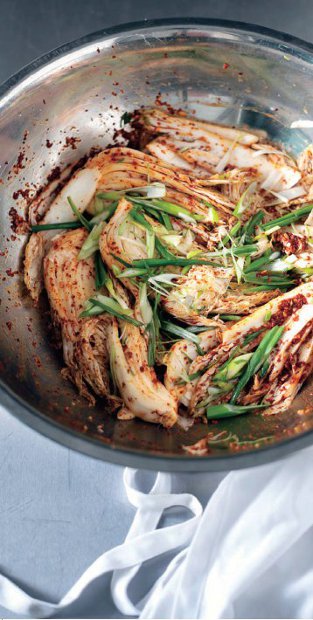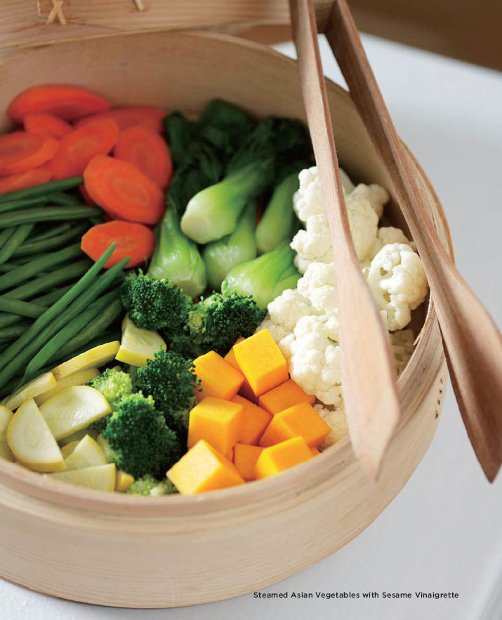
SIDE DISHES
I am reluctant to call these “side dishes,” since they are much more than that. Granted, they are simple dishes that focus on one or two main ingredients, but who says a main meal should be fussy? All meals should begin with a raw salad, followed with cooked vegetables if desired.
Often, when I’m at a restaurant, I ask for the best-looking side vegetables on the menu to be plated together for my main course—carrots, portobellos, brussels sprouts, butternut squash, and so on. You can use these recipes, which stand strong on their own, as side dishes or choose your favorite ones to be the centerpiece of your meal. One of my nightly favorites is a great big green salad coupled with a delicious side of my favorite cooked vegetable. It’s the perfect combination of refreshing, water-containing food and hearty cooked comfort food.
—NATALIA
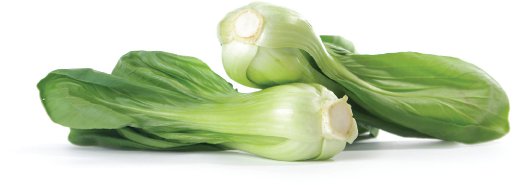
STEAMED VEGETABLES
The healthiest way to enjoy minimally cooked vegetables is to steam them, allowing them to keep their nutritional integrity intact. There are no rules for steaming vegetables other than to err on the al dente side. Don’t overcook them unless you have a fondness for cafeteria food. Steamed vegetables that are eaten cold as crudité will benefit from an ice-water bath to halt the cooking and keep the colors vibrant. Sea salt and pepper is the simplest seasoning, but to make it a bit more exciting, try the recipes below.
Steamed Asian Vegetables with Sesame Vinaigrette
You can use any assortment of vegetables, but the trick is to slice and chop the vegetables so they steam evenly at the same time.
FOR THE STEAMED VEGETABLES:
1 medium carrot, sliced ¼-inch thick
1 cup broccoli florets
1 cup sliced shiitake mushrooms, or handful of enoki mushrooms
1 cup sliced asparagus
Handful of snow peas
Handful of napa cabbage, chopped in 1-inch pieces
Handful of bok choy, chopped in 1-inch pieces
FOR THE VINAIGRETTE:
1 tablespoon sesame paste (tahini)
2 tablespoons rice vinegar or lemon juice
1 tablespoon nama shoyu
2 tablespoons water
½ teaspoon grated ginger
2-3 drops liquid stevia
Steam the vegetables for 5−7 minutes until al dente. To make the vinaigrette, whisk all the ingredients until smooth. Serve the steamed vegetables with the sauce on the side.
SERVES 4
Steamed Okra with Roasted Red Pepper Sauce
I love okra fresh from the farmers’ market. Once, I ate a half pint of raw okra while waiting in line to pay, and the farmer caught me. He was astonished to learn that one can eat it raw. It is crunchy and delicious without the gooeyness of overcooked okra. Steaming okra also preserves its freshness and minimizes the gooey factor.
1 pound okra, caps removed
Roasted Red Pepper Sauce (see page 104)
Steam the okra whole for 5 minutes until al dente. Toss with the sauce and serve.
SERVES 4
Steamed Zucchini Spears with Korean Dipping Sauces
Fill up on this light, yummy finger food before heavier dishes. It’s sweet, spicy, and vinegary.
2 medium zucchini, cut into spears
Korean Red Pepper Sauce (see page 111)
Shoyu Vinaigrette (see page 111)
Steam the zucchini for 5−7 minutes until al dente. Serve with the sauces on the side.
SERVES 2–4
PUREED AND MASHED VEGETABLES
Pureed vegetables make dishes simple but elegant. They should be smooth, silky, and without any stringy fibers. Mashed vegetables are thicker, more rustic, and sometimes lumpy. Either way, these vegetable sides are not just for babies.
Here are a few rules for pureeing and mashing: Fully cook the vegetables until soft and easily pierced with a fork. Remove the stems and tough fibers from vegetables such as cauliflower, broccoli, and celery for silky, smooth purees. For moisture-robbing vegetables such as eggplants and zucchini, dry roast or bake them first instead of cooking them in water. Season your purees with herbs, spices, cream, and/or butter as desired.
Carrot Ginger Puree
I love this warm, savory puree over steamed quinoa, millet, or buckwheat noodles, with a medley of steamed vegetables such as broccoli, kale, and cabbage.
2 large carrots, scrubbed and chopped into 1-inch pieces
1 small onion, chopped
1 knob ginger, thinly sliced
1 garlic clove, halved
5 sprigs thyme
1 bay leaf
4 cups water
Salt and pepper
Place all the ingredients in a medium-size pot and bring to a boil. Lower the heat and simmer until the carrots are fully cooked (about 30 minutes). Remove the thyme sprigs and bay leaf and place the rest of the ingredients in a blender with 1 cup of the cooking liquid. Puree until smooth. Season with salt and pepper as desired.
SERVES 4
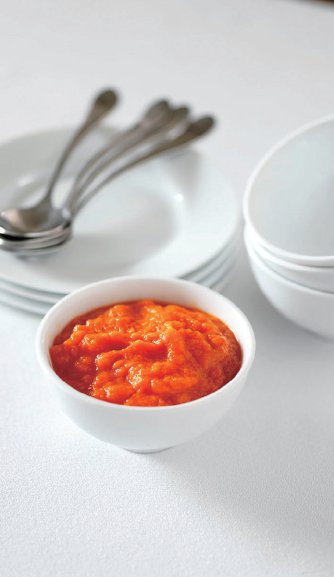
Basic Cauliflower Puree
This makes a great side dish with roasted portobello mushroom steaks or roasted fish. To jazz it up, add a tablespoon of minced herbs (thyme, rosemary, or basil) or a teaspoon of spices (curry, cumin, or smoked paprika). For a cheesy puree, add goat cheese or nutritional yeast.
1 head of cauliflower, broken evenly into florets
1 tablespoon butter
Sea salt to taste
½ cup grated goat cheddar or ¼ cup nutritional yeast (optional)
Steam the cauliflower until fully cooked (at least 10 minutes). Place half the cauliflower in a blender with ¼ cup of the steaming liquid to facilitate blending. Add the remaining cauliflower and butter, and season with sea salt. To make the puree cheesy, add grated cheese or nutritional yeast.
SERVES 4
Beet Balsamic Puree
This is a great accompaniment to roasted root vegetables as well as grilled endive or radicchio. The puree is rich and intense, so several tablespoons per serving will go a long way.
2 cups cubed roasted beets
2 tablespoons balsamic vinegar
1 tablespoon extra-virgin olive oil
¼ cup water, as needed
Stevia to taste
Sea salt and pepper to taste
Place all the ingredients in a blender, adding water as needed to facilitate blending. Season with stevia, sea salt, and pepper as desired.
SERVES 4
Butternut Sage Puree
When no one is looking, I eat this straight from my blender, using my rubber spatula as a spoon. It has all the flavors of a Thanksgiving dinner for a deeply soul-satisfying dish. You can eat it over pasta or a bowl of millet. It is also delicious on its own as a soup.
1 medium butternut squash (about 2 ½ pounds)
2 garlic cloves, minced
5 sage leaves, finely chopped
½ cup All-Purpose Vegetable Stock (see page 92)
Sea salt and pepper to taste
Preheat the oven to 400°F. Cut the butternut squash in half and scoop out the seeds and membrane. Place the garlic and sage inside the cavities and flip over onto a parchment-lined baking tray. Roast for 30−40 minutes until soft. With a spoon, scoop out the flesh, along with the garlic and the sage, and transfer to a food processor or blender. Add the stock as needed to facilitate blending until smooth. Season with sea salt and pepper as desired.
SERVES 4
ROASTED VEGETABLES
Roasting vegetables is simple: You just bake the vegetables on a parchment-lined baking tray at 400°F. Cooking times depend on their thickness and density. Asparagus and zucchini might take 15 minutes; cruciferous vegetables such as broccoli, cauliflower, and cabbage might take 20 minutes; and starchy vegetables such as yams and sweet potatoes need at least 30−45 minutes. Also keep in mind how the vegetable is prepared. If it is shredded or sliced, it will take less time to roast than a vegetable that is roasted whole. Err on the al dente side.
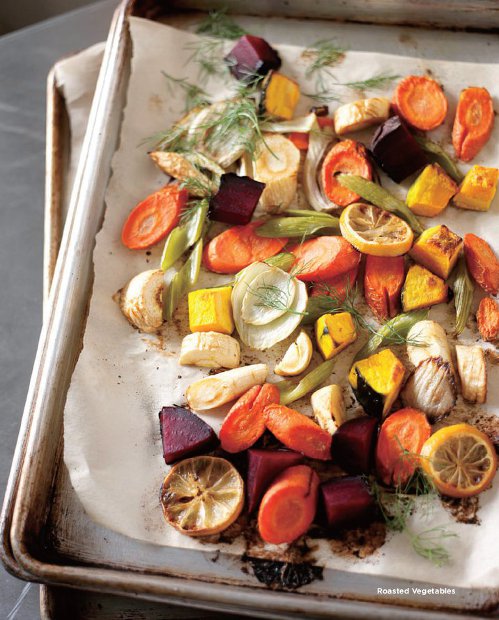
Experiment with roasting vegetables without oils. Instead, add a drizzle of olive oil afterward, along with some fresh herbs. A pat of butter is a better option as butter can tolerate the heat better than oil. A squeeze of lemon brightens and refreshes most roasted vegetables.
EACH SERVES 2–4
FOR THE FOLLOWING VEGETABLES:
Preheat the oven to 400°F, combine all the ingredients, season with salt and pepper, and roast for 15 minutes. Add garnishes and/or lemon juice after cooking.
ASPARAGUS
1 bunch asparagus, woody stems trimmed
2 ounces shredded raw sheep pecorino for garnish
Fresh lemon juice for garnish
BRUSSELS SPROUTS (PICTURED)
1 pint brussels sprouts, shredded
1 garlic clove, minced
1 tablespoon thyme leaves
SAVOY CABBAGE
1 head savoy cabbage, shredded
1 tablespoon butter
SWISS CHARD
1 bunch Swiss chard, chopped into 2-inch pieces
1 garlic clove, minced
Fresh lemon juice
COLLARD GREENS
1 bunch collard greens, cut into ¼-inch ribbons
1 small red onion, thinly sliced
1 teaspoon cumin
Fresh lemon juice
SCALLIONS, LEEKS & RAMPS
1 pound scallions, leeks, and/or ramps, trimmed but whole
1 tablespoon butter
Fresh lemon juice
FOR THE FOLLOWING VEGETABLES:
Preheat the oven to 400°F, combine all the ingredients, season with salt and pepper, and roast for 20−25 minutes. Add garnishes and/or lemon juice after cooking.
KALE
1 bunch kale, stems removed and cut into bite-size pieces
1 teaspoon coconut oil
1 tablespoon curry
Fresh lemon juice
CAULIFLOWER (PICTURED)
1 head cauliflower, cut into large florets
1 small red onion, thinly sliced
2 garlic cloves, minced
1 stalk rosemary, minced
1 lemon, thinly sliced
1 teaspoon paprika
1 tablespoon raw pine nuts for garnish
Chopped parsley for garnish
SWEET ONIONS
2 large sweet Maui or Vidalia onions, sliced ½-inch thick
2 tablespoons butter
2 garlic cloves
1 teaspoon thyme leaves
1 teaspoon chopped oregano
1 tablespoon chopped parsley
2 ounces raw sheep pecorino
MISO GLAZED EGGPLANT (PICTURED)
4 medium Japanese eggplants, halved lengthwise
2 tablespoons white miso
2 tablespoons mirin
Place the eggplant halves flesh-side up on a baking tray. Combine the miso and mirin to form a thin paste and brush on the eggplants before roasting.
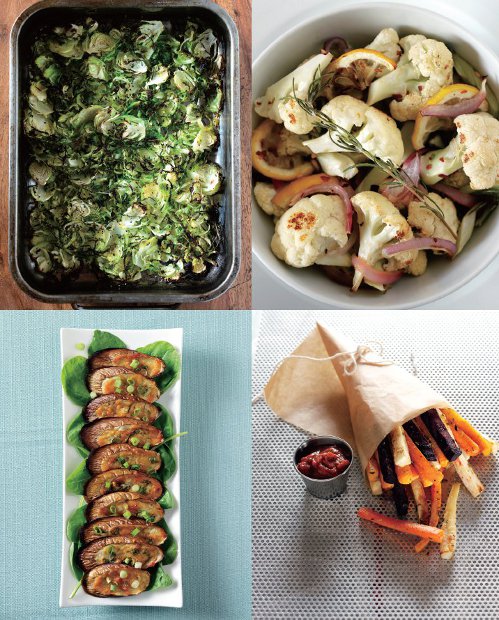
FENNEL
1 bulb fennel, thinly sliced (reserve fronds for garnish)
1 teaspoon thyme leaves
1 small orange or grapefruit, sliced
1 tablespoon fennel fronds for garnish
FOR THE FOLLOWING RECIPES:
Preheat the oven to 400°F, combine all the ingredients, season with salt and pepper, and roast for 30−40 minutes. Add garnishes and/or lemon juice after cooking.
TURNIPS
4 large turnips, quartered
1 tablespoon butter
1 tablespoon chopped tarragon
TERIYAKI KABOCHA SQUASH
1 medium kabocha squash, halved, seeded, and cut into 1-inch wedges
2 tablespoons nama shoyu
1 tablespoon toasted sesame oil
2 tablespoons agave nectar
2 garlic cloves, minced
1 knob ginger, minced
FIVE-SPICE KABOCHA SQUASH
1 medium kabocha squash, halved, seeded and cut into 1-inch wedges
1 tablespoon Chinese Five-Spice Powder (see page 60)
BUTTERNUT SQUASH
1 large butternut squash, peeled and cut into 1-inch cubes
1 tablespoon butter
2 garlic cloves, minced
1 tablespoon chopped sage
ROOT VEGETABLE FRIES (PICTURED, PAGE 191)
Cut carrots, parsnip, beets, sweet potatoes, butternut squash, and/or sweet potatoes into “steak frites,” approximately ¾-inch thick. Season with any spice blend. Lightly toss with coconut oil or a pat of butter. Turn the fries halfway through cooking to brown evenly on all sides.
WHOLE SWEET POTATO, YAM, OR BEET
Wrap in parchment paper, cover with tinfoil, and roast until the center is soft when pierced with a fork (up to 1 hour for larger vegetables).
PICKLED VEGETABLES (PROBIOTICS)
Products such as pickles, vinegars, and sauerkraut that come from a container in the supermarket are acidic and devoid of life force. Eating them for their probiotic qualities is an act of futility and will do more harm than good. However, freshly fermented dishes such as raw kimchis and fresh pickles will cultivate beautiful and lush intestinal flora that will aid digestion and ease symptoms of ailments such as acid reflux, IBS, and Crohn’s disease. Probiotics also play an important part in eradicating yeast and fungus from the body because the powerful cultivation of good bacteria helps to stem fungal growth. Fresh fermented foods should be enjoyed alone on an empty stomach, before a meal, or as a snack, for at least 4 days in a row to cultivate successfully. The following Korean-inspired recipe is a classic probiotic standby.
Cabbage Kimchi
Many traditional kimchis may contain anchovies, shrimp paste, or oysters. This is a straightforward vegan recipe.
1 large napa cabbage, quartered, keeping the leaves whole and the tops intact
½ cup coarse sea salt
10 garlic cloves, minced
1 large knob ginger, peeled and minced
5 scallions, chopped
½ cup gochugaru (Korean red pepper powder)
Rub the cabbage leaves with half of the salt and let sit at room temperature for at least 4 hours to soften.
Rinse out the salt and squeeze out any excess moisture.
Mix the garlic, ginger, scallions, and gochugaru together with a little water to form a paste or slurry. Rub the paste on the leaves of the cabbage, carefully getting between each layer. (It might be a good idea to wear gloves to protect your hands from the heat of the spices.)
Pack the cabbage sections into a large sterile jar, carefully pushing each layer down so that all of the oxygen is forced out. Place a plate on top to tamp down all the cabbage into the jar, seal it, and leave out at room temperature.
After 2 or 3 days, check your kimchi. The cabbage should be slightly transparent and tangy. Refrigerate and enjoy within the week for maximum probiotic health.
MAKES 1 QUART
